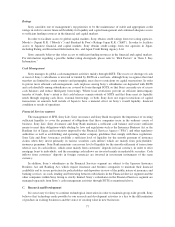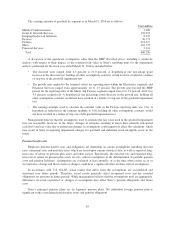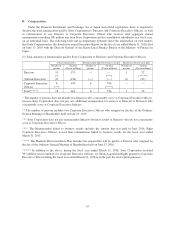Sony 2015 Annual Report Download - page 87
Download and view the complete annual report
Please find page 87 of the 2015 Sony annual report below. You can navigate through the pages in the report by either clicking on the pages listed below, or by using the keyword search tool below to find specific information within the annual report.As a result of losses incurred in recent years, Sony Corporation and several subsidiaries in Japan, Sony
Americas Holding Inc. (“SAHI”) and its consolidated tax filing group in the U.S., Sony Mobile Communications
AB in Sweden, Sony Europe Limited (“SEU”) in the U.K., certain subsidiaries in Brazil, and certain entities in
other tax jurisdictions are each in cumulative loss positions. A cumulative loss position is considered significant
negative evidence in assessing the realizability of a deferred tax asset that is difficult to overcome when
determining that a valuation allowance is not needed against deferred tax assets.
The amount of the deferred tax assets as it relates to Sony Corporation, SAHI, Sony Computer
Entertainment Inc., Sony Computer Entertainment Europe Limited and SEU takes into account the uncertain tax
positions related to the more likely than not adjustments for Sony’s intercompany transfer pricing. Such transfer
pricing is currently under review by the relevant governments as a result of applications for Bilateral Advance
Pricing Agreements (“APAs”) filed in the U.S., the U.K. and Japan. Sony is required to estimate the final
outcome of those government to government negotiations in recording its tax positions, including the allocation
and amount of deferred tax assets among the various legal entities as of the balance sheet date. Sony reviews its
estimated tax expense based on the progress made in these procedures, and the progress of transfer pricing audits
generally, and makes adjustments to its estimates as necessary.
It is possible that advance pricing agreement negotiations could result in a different allocation of profits and
losses than those currently estimated by management, and that such allocation could have a positive or negative
impact on the amount or realizability of deferred tax assets or could change the amount of the valuation
allowances recorded. Sony may record adjustments to its provision for uncertain tax positions and, accordingly,
to its valuation allowance assessments, as additional evidence becomes available.
The estimate for the valuation of deferred tax assets, which is based on currently enacted tax laws and rates
as of the balance sheet date, reflects management’s judgment and best estimate of the likely future tax
consequences of events that have been recognized in Sony’s financial statements and tax returns, the ability to
implement various tax planning strategies and, in certain cases, future forecasts, business plans and other
expectations about future outcomes. Changes in existing tax laws or rates in tax jurisdictions in which Sony
operates could affect actual tax results, and market or economic deterioration or failure of management to
achieve its restructuring objectives could affect future business results, either of which could affect the valuation
of deferred tax assets over time. If future results are less than projected, if negotiations of the APAs result in a
different allocation of profits and losses than currently anticipated, if tax planning alternatives are no longer
viable, or if there is no excess appreciated asset value over the tax basis of the assets contemplated for sale,
further valuation allowance may be required in the future to reduce the deferred tax assets to their net realizable
value. On the other hand, an improvement in future results, or other factors such as business reorganizations,
could lead to the future reversal of valuation allowance into income as a reduction to tax expense, subject to
review of the relevant qualitative factors and uncertainties. These factors and other changes that are not
anticipated in current estimates could have a material impact on Sony’s earnings or financial condition in the
period or periods in which the impact is recorded or reversed.
Film accounting
An aspect of film accounting that requires the exercise of judgment relates to the process of estimating the
total revenues to be received throughout a film’s life cycle. Such estimate of a film’s ultimate revenue is
important for two reasons. First, while a film is being produced and the related costs are being capitalized, it is
necessary for management to estimate the ultimate revenue, less additional costs to be incurred, including
exploitation costs which are expensed as incurred, in order to determine whether the value of a film has been
impaired and thus requires an immediate write-off of unrecoverable film costs. Second, the amount of film costs
recognized as cost of sales for a given film as it is exhibited in various markets throughout its life cycle is based
upon the proportion that current period actual revenues bear to the estimated ultimate total revenues.
Management bases its estimates of ultimate revenue for each film on several factors including the historical
performance of similar genre films, the star power of the lead actors and actresses, the expected number of
theaters at which the film will be released, anticipated performance in the home entertainment, television and
other ancillary markets, and agreements for future sales. Management updates such estimates on a regular basis
87
























